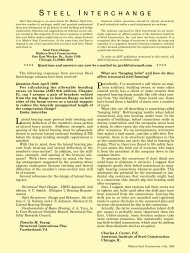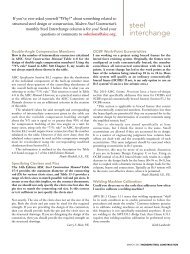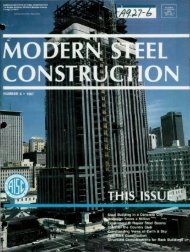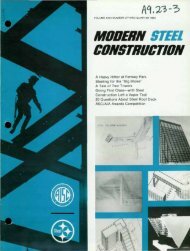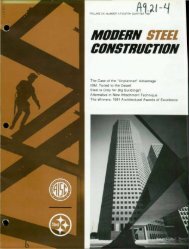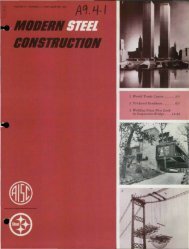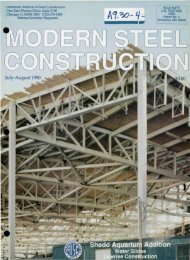Larger Hollow Structural Sections - Modern Steel Construction
Larger Hollow Structural Sections - Modern Steel Construction
Larger Hollow Structural Sections - Modern Steel Construction
Create successful ePaper yourself
Turn your PDF publications into a flip-book with our unique Google optimized e-Paper software.
steelwise<br />
<strong>Larger</strong> <strong>Hollow</strong> <strong>Structural</strong> <strong>Sections</strong><br />
by Jie Zuo<br />
New larger sizes of square and rectangular HSS offer engineers and<br />
architects more opportunities to use these efficient shapes.<br />
THE pOpULaRITy of hollow structural sections (HSS)<br />
in construction has increased dramatically over the years<br />
as engineers have become aware of the advantages of HSS<br />
and perceived difficulties of designing HSS connections<br />
have been addressed. The inclusion of an HSS connection<br />
chapter in the AISC Specification (Chapter K in ANSI/AISC<br />
360) and design recommendations and aids in the recently<br />
published AISC <strong>Steel</strong> Design Guide No. 24, <strong>Hollow</strong> <strong>Structural</strong><br />
Section Connections, (available as a free download for AISC<br />
members at www.aisc.org/epubs) have simplified connection<br />
design and contributed to the rise in use of HSS.<br />
HSS are very efficient sections and their major benefits<br />
are inherent in their shape and engineering properties.<br />
Their closed shape and relatively large moment of inertia<br />
about the weak axis make them highly resistant against torsional<br />
and lateral-torsional effects. They are particularly<br />
well suited for axial compression members that have similar<br />
unbraced lengths in both directions because of a favorable<br />
weak-axis radius of gyration, which often controls the available<br />
capacity.<br />
The benefits extend beyond structural considerations<br />
to artistic and economic needs as well. Architects can take<br />
advantage of the modern and aesthetically pleasing appearance<br />
of exposed HSS. In exposed applications, HSS can<br />
become an attractive part of the building’s visual display,<br />
reducing shadows and obscuring spaces.<br />
The unit material cost of HSS is higher than that of open<br />
cross sections, but that is not the whole story. The additional<br />
strength can permit a lighter design, in some applications.<br />
Two examples in Design Guide 24 compare W-shape and<br />
HSS compression members with similar load capacities. For<br />
a W8×31, which is 8 in. deep and has an 8-in.-wide flange,<br />
the comparable round HSS7.500×0.375 is 8% lighter while<br />
HSS8×8×1/4 is 17% lighter. Similarly a W14×109 is comparable<br />
in size and capacity to the round HSS14.000×0.625<br />
and HSS14×14×1/2, but for both the HSS is 18% lighter.<br />
Reducing the weight also saves in transportation and erec-<br />
MODERN STEEL CONSTRUCTION november 2011<br />
Jie Zuo is a staff engineer with AISC.<br />
Your connection to<br />
ideas + answers<br />
tion costs. In those applications where paint or fireproofing is<br />
required, the fact that HSS has 1 ⁄3 to 1/2 less surface area than<br />
comparable W-shapes can result in using less material and<br />
reducing application time, both of which reduce costs. Furthermore,<br />
the surfaces are relatively easy to clean and the lack<br />
of protruding corners reduces susceptibility to corrosion.<br />
In specialized applications, HSS are extremely versatile<br />
and can be used in a variety of applications. Circular hollow<br />
sections are especially favorable to resist wind loadings<br />
because of their low drag coefficients. The hollow interior<br />
can be filled with concrete or other materials to utilize composite<br />
action to form a stronger member, as well as increasing<br />
its durability under fire conditions.<br />
A recent change to the ASTM A500 standard has increased<br />
the maximum periphery of cold-formed HSS from 64 in. to<br />
88 in. and the maximum wall thickness from 0.688 in. to<br />
0.875 in. Taking full advantage of this opportunity, Atlas<br />
Tube—the largest HSS producer in North America—is pursuing<br />
an agreement with an offshore producer to provide<br />
new jumbo-sized A500 HSS. Prior to the introduction of<br />
these new shapes, square sections up to 16 in. and 0.625 in.<br />
wall thickness were readily available. The jumbo A500 HSS<br />
of 18 in., 20 in., and 22 in. square sections and associated<br />
rectangles with wall thickness from 0.500 in. to 0.875 in. are<br />
expected to be available soon.<br />
Even beyond the opportunities provided by these large<br />
A500 shapes, rounds, squares and rectangles outside the<br />
➤<br />
one of the last steps in producing HSS involves<br />
straightening of the walls in a Turk’s head, shown here.<br />
Atlas Tube
perimeter limits of A500 also are being made available in the marketplace.<br />
They are built up from plates and classified as box sections.<br />
The distinction with this line of HSS is not only dimensional—there<br />
are differences in material and production techniques as well. The<br />
specifier also must evaluate the material because it falls outside the<br />
limits of ASTM A500.<br />
Typically, square or rectangular sections within the dimensional<br />
limits of A500 are produced with one of two methods. The first<br />
involves running a flat steel strip through a progressive set of rollers<br />
to continuously cold form the strip into a round cross section.<br />
The edges are fused together with a continuous electric resistance<br />
seam weld, which does not involve the addition of any filler metal.<br />
The resulting tube then is fed into another stand of rollers to precision<br />
form the size and shape of the product, either round or rectangular,<br />
followed by straightening of the walls in what is called a<br />
Turk’s head.<br />
Alternatively, for rectangular shapes only, some producers use<br />
a second method of production that consists of feeding a flat steel<br />
strip through driven forming dies that progressively cold bend the<br />
corners of the section. In this method, no bending is performed on<br />
Shape<br />
Shape<br />
Design Wall<br />
Thickness, t<br />
Nominal<br />
W t<br />
area,<br />
a b/t h/t<br />
I S r Z<br />
Torsion Surface<br />
area<br />
J C<br />
in. lb/ft in. 2 in. 4 in. 3 in. in. 3 in. 4 in. 3 ft 2 /ft<br />
HSS22×22× 7 ⁄8 0.814 244.88 67.3 24.0 24.0 4970 452 8.59 530 7890 729 7.10<br />
×¾ 0.698 212.00 58.2 28.5 28.5 4350 395 8.65 462 6860 632 7.13<br />
HSS20×20× 7 ⁄8 0.814 221.06 60.8 21.6 21.6 3670 367 7.77 433 5870 597 6.43<br />
×¾ 0.698 191.58 52.6 25.7 25.7 3230 323 7.84 378 5110 519 6.47<br />
× 5 ⁄8 0.581 161.40 44.3 31.4 31.4 2750 275 7.88 320 4320 437 6.50<br />
×½ 0.465 130.52 35.8 40.0 40.0 2260 226 7.95 261 3510 355 6.53<br />
HSS18×18× 7 ⁄8 0.814 197.24 54.3 19.1 19.1 2630 292 6.96 346 4220 479 5.77<br />
×¾ 0.698 171.16 47.1 22.8 22.8 2320 258 7.02 302 3690 417 5.80<br />
× 5 ⁄8 0.581 144.39 39.6 28.0 28.0 1980 220 7.07 257 3120 352 5.83<br />
×½ 0.465 116.91 32.1 35.7 35.7 1630 181 7.13 210 2540 286 5.87<br />
HSS16×16× 7 ⁄8 0.814 173.43 47.7 16.7 16.7 1800 225 6.14 268 2920 373 5.10<br />
×¾ 0.698 150.75 41.5 19.9 19.9 1590 199 6.19 235 2560 326 5.13<br />
HSS14×14× 7 ⁄8 0.814 149.61 41.2 14.2 14.2 1170 167 5.33 201 1910 281 4.43<br />
×¾ 0.698 130.33 35.9 17.1 17.1 1040 149 5.38 177 1680 246 4.47<br />
HSS12×12×¾ 0.698 109.91 30.3 14.2 14.2 631 105 4.56 127 1030 177 3.80<br />
HSS10×10×¾ 0.698 89.50 24.7 11.3 11.3 347 69.4 3.75 84.7 578 119 3.13<br />
Design Wall<br />
Thickness, t<br />
Nominal<br />
W t<br />
Dimensions and Properties for Jumbo Square HSS<br />
Dimensions and Properties for Jumbo rectangular HSS<br />
area,<br />
a b/t h/t<br />
the side walls of the section. The square or rectangle is also completed<br />
with the electric resistance seam weld process.<br />
In the United States, ASTM A500 Grades B and C material is<br />
generally used for cold-formed HSS with yield strengths 46 ksi<br />
and 50 ksi, respectively. Other materials, including those with<br />
increased atmospheric corrosion resistance, may also be available<br />
upon request. There is a ±10% thickness tolerance on the walls<br />
that results in the mills consistently producing HSS with thicknesses<br />
less than that of nominal. The AISC Specification has taken<br />
this into account by imposing a 7% reduction in the nominal wall<br />
thickness to be used in design.<br />
A third method of production, not involving ASTM A500 or<br />
resistance seam welding, also exists wherein box sections are produced<br />
by placing two A572 Grade 50 flat steel plates in a brake<br />
press to form two identical halves of a complete tube. A backing<br />
bar is tack welded to both legs of one of the half sections. Then,<br />
the half sections are butted together toe-to-toe and submerged arc<br />
welded at the seams to form the complete square or rectangular<br />
section. ASTM A1065—a product specification for box sections—<br />
permits alternative plate materials and welding processes. While<br />
axis X-X axis y-y Torsion Surface<br />
area<br />
I S r Z I S r Z J C<br />
in. lb/ft in. 2 in. 4 in. 3 in. in. 3 in. 4 in. 3 in. in. 3 in. 4 in. 3 ft 2 /ft<br />
HSS24×12×¾ 0.698 171.16 47.1 14.2 31.4 3440 287 8.55 359 1170 195 4.98 221 2850 366 5.80<br />
× 5 ⁄8 0.581 144.39 39.6 17.7 38.3 2940 245 8.62 304 1000 167 5.03 188 2430 310 5.83<br />
×½ 0.465 116.91 32.1 22.8 48.6 2420 202 8.68 248 829 138 5.08 154 1980 252 5.87<br />
HSS20×12×¾ 0.698 150.75 41.5 14.2 25.7 2190 219 7.26 270 988 165 4.88 190 2220 303 5.13<br />
HSS16×12×¾ 0.698 130.33 35.9 14.2 19.9 1270 159 5.95 193 810 135 4.75 158 1610 240 4.47<br />
november 2011 MODERN STEEL CONSTRUCTION
Effective length KL (ft) with respect to least radius of gyration r y<br />
Jumbo Square HSS Shapes<br />
Available Strength in Axial Compression, kips<br />
P n/c (ASD), cPn (LRFD)<br />
MODERN STEEL CONSTRUCTION november 2011<br />
Fy = 46 ksi<br />
cPn = 0.90FcrAg<br />
Pn/c=FcrAg/1.67 Shape<br />
HSS22x22x<br />
7/8<br />
3/4<br />
7/8<br />
HSS20x20x<br />
3/4 5/8<br />
t design, in 0.814<br />
0.698<br />
0.814 0.698 0.581<br />
Wt/ft 244<br />
212<br />
221 191 161<br />
Design<br />
Pn/Ωc ASD<br />
φcPn<br />
LRFD<br />
Pn/Ωc<br />
ASD<br />
φcPn<br />
LRFD<br />
Pn/Ωc<br />
ASD<br />
φcPn<br />
LRFD<br />
Pn/Ωc<br />
ASD<br />
φcPn<br />
LRFD<br />
Pn/Ωc<br />
ASD<br />
φcPn<br />
LRFD<br />
0 1850 2790 1600 2410 1670 2520 1450 2180 1220 1830<br />
6 1850 2770 1600 2400 1670 2500 1440 2170 1210 1820<br />
7 1840 2770 1590 2390 1660 2500 1440 2160 1210 1820<br />
8 1840 2760 1590 2390 1660 2490 1430 2160 1210 1820<br />
9 1830 2760 1590 2380 1650 2480 1430 2150 1200 1810<br />
10 1830 2750 1580 2380 1650 2480 1430 2140 1200 1810<br />
11 1820 2740 1580 2370 1640 2470 1420 2140 1200 1800<br />
12 1820 2730 1570 2360 1640 2460 1420 2130 1190 1790<br />
13 1810 2730 1570 2360 1630 2450 1410 2120 1190 1790<br />
14 1810 2720 1560 2350 1620 2440 1400 2110 1180 1780<br />
15 1800 2710 1560 2340 1620 2430 1400 2100 1180 1770<br />
16 1790 2690 1550 2330 1610 2420 1390 2090 1170 1760<br />
17 1780 2680 1540 2320 1600 2400 1380 2080 1170 1750<br />
18 1780 2670 1540 2310 1590 2390 1380 2070 1160 1740<br />
19 1770 2660 1530 2300 1580 2380 1370 2060 1150 1730<br />
20 1760 2640 1520 2290 1570 2360 1360 2040 1150 1720<br />
21 1750 2630 1510 2280 1560 2350 1350 2030 1140 1710<br />
22 1740 2610 1510 2260 1550 2330 1340 2020 1130 1700<br />
23 1730 2600 1500 2250 1540 2310 1330 2000 1120 1690<br />
24 1720 2580 1490 2240 1530 2290 1320 1990 1120 1680<br />
25 1710 2570 1480 2220 1510 2280 1310 1970 1110 1660<br />
26 1700 2550 1470 2210 1500 2260 1300 1960 1100 1650<br />
27 1680 2530 1460 2190 1490 2240 1290 1940 1090 1640<br />
28 1670 2510 1450 2180 1480 2220 1280 1920 1080 1620<br />
29 1660 2490 1440 2160 1460 2200 1270 1910 1070 1610<br />
30 1650 2480 1430 2140 1450 2180 1260 1890 1060 1590<br />
32 1620 2440 1400 2110 1420 2140 1230 1850 1040 1560<br />
34 1590 2390 1380 2070 1390 2090 1210 1810 1020 1530<br />
36 1560 2350 1360 2040 1360 2040 1180 1780 1000 1500<br />
38 1530 2310 1330 2000 1330 2000 1150 1730 974 1460<br />
40 1500 2260 1300 1960 1300 1950 1130 1690 951 1430<br />
Properties<br />
2<br />
Ag (in. )<br />
67.3<br />
58.2 60.8 52.6 44.3<br />
4<br />
Ix (in. ) 4970<br />
4<br />
Iy (in. ) 4970<br />
rx/ry 1.00<br />
ry (in.) 8.59<br />
c<br />
Section is slender for axial compression.<br />
4350<br />
4350<br />
1.00<br />
8.65<br />
3670<br />
3670<br />
1.00<br />
7.77<br />
3230<br />
3230<br />
1.00<br />
7.84<br />
2750<br />
2750<br />
1.00<br />
7.88<br />
➤<br />
example of the jumbo HSS member selection tables<br />
available as downloads.<br />
A1065 includes sections up to 192 in. in periphery and 1 in. in wall thickness,<br />
more common sizes range between 64 in. to 120 in. in periphery.<br />
The standard weld permits a partial joint penetration groove weld where<br />
the groove thickness is at least 80% of the material thickness. Complete<br />
joint penetration groove welds can be provided if specified with additional<br />
inspection requirements. Consisting of structural plate material,<br />
A1065 boxes have a yield strength of 50 ksi, equivalent to that of A500<br />
Grade C HSS. The thickness tolerance of +0.03/-0.01 in. is tighter than<br />
that of A500, and the nominal wall thickness reduction of 0.93t nom does<br />
not apply in design.<br />
Standard Dimensions<br />
With the expansion of the range of HSS sizes comes an opportunity<br />
for designers to benefit from a multitude of design possibilities and more<br />
efficient structural solutions. Tables showing engineering properties of<br />
the jumbo A500 HSS are included here for the use of designers. These<br />
tables include the same data as the HSS property tables (Tables 1-11 and<br />
1-12) in the AISC <strong>Steel</strong> <strong>Construction</strong> Manual. For the purposes of facilitating<br />
column design, extensions to Manual Tables 4-3 and 4-4 listing<br />
available strength in axial compression have also been tabulated for all<br />
the new shapes and can be downloaded for free at www.aisc.org/hss.<br />
The standard sizes of HSS and box sections produced are available<br />
on the <strong>Steel</strong> Availability page on the AISC website (www.aisc.org/<br />
availability). Availability of the jumbo A500 HSS should be confirmed<br />
by the supplier before use in design. Sizes, engineering properties and<br />
other technical data will also be available from the supplier.



